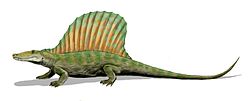| Ruthiromia Temporal range: Early Permian | |
|---|---|
| Scientific classification | |
| Domain: | Eukaryota |
| Kingdom: | Animalia |
| Phylum: | Chordata |
| Clade: | Synapsida |
| Family: | † Varanopidae |
| Subfamily: | † Varanopinae |
| Genus: | † Ruthiromia Eberth & Brinkman, 1983 |
| Type species | |
| †Ruthiromia elcobriensis Eberth & Brinkman, 1983 | |
Ruthiromia is an extinct genus of varanopid synapsids from the Early Permian of the United States.





